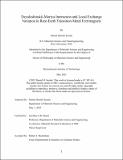Dzyaloshinskii-Moriya Interaction and Local Exchange Variation in Rare-Earth Transition-Metal Ferrimagnets
Author(s)
Suzuki, Daniel Hiroshi
DownloadThesis PDF (4.356Mb)
Advisor
Beach, Geoffrey S.D.
Terms of use
Metadata
Show full item recordAbstract
Spintronics utilizes the spin of electrons in addition to its charge to manipulate magnetism in thin films. Research in spintronics has the potential to usher in a new wave of technologies, particularly in next-generation racetrack memory storage. These technologies rely on the motion of chiral spin textures such as domain walls or skyrmions in order to read and write data. Rare-earth (RE) transition-metal (TM) ferrimagnetic heterostructures are especially promising candidates due to their minimal stray fields and vanishing angular momentum near compensation, and have already exhibited high-speed current-induced domain wall motion and ultra-small skyrmion stability at room temperature.
The stability of the chiral spin textures necessary for racetrack and skyrmionic memory is governed by an antisymmetric magnetic exchange interaction known as the Dzyaloshinskii-Moriya Interaction (DMI). Unlike the symmetric Heisenberg interaction that favors collinear spin alignment and gives rise to ferromagnetism and antiferromagnetism, the DMI favors canting of spins perpendicular to its neighbors. While DMI has been extensively studied in ferromagnetic systems, little work has been done to quantify its strength in ferrimagnetic systems. In this thesis the compositional dependence of a number of static and dynamic magnetic properties of RE-TM amorphous ferrimagnets necessary for the design of chiral spin texture-based technologies is investigated. We develop a simple method for determining magneto-optical Kerr angles that informs efficient design of magneto-optical Kerr effect microscopes. Additionally, we observe a significant variation in both RE and TM average atomic moment as a function of composition well described by a local environment model as well as substantial variation in magnetization as a function of RE-TM film thickness. Finally, current-induced domain wall motion is used to characterize the spin-transport properties and DMI of RE-TM films.
Date issued
2023-06Department
Massachusetts Institute of Technology. Department of Materials Science and EngineeringPublisher
Massachusetts Institute of Technology